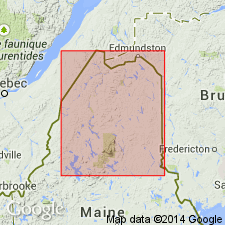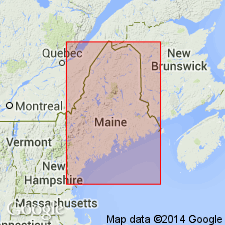
- Usage in publication:
-
- Estcourt Road Formation
- Modifications:
-
- Named
- Dominant lithology:
-
- Phyllite
- Sandstone
- Siltstone
- Slate
- AAPG geologic province:
-
- New England province
Summary:
The "Estcourt Road sequence" of Boudette and others (1976) in northern Maine is here named the Estcourt Road Formation. It consists of medium-gray to black phyllite interlayered with thin beds of calcareous quartzo-feldspathic fine-grained sandstone or siltstone, with local lentils of red, green, and gray phyllite or slate interlayered with quartzite. Limestone conglomerate and "melange" of chert and graywacke blocks in black phyllite occur locally. Correlates with the Quebec Group along strike to the northeast and with the Rosaire Group to the west and southwest. Underlies the Depot Mountain Formation along the Dead Brook fault. Age is Cambrian and (or) Early Ordovician.
Source: GNU records (USGS DDS-6; Reston GNULEX).

- Usage in publication:
-
- Estcourt Road Formation†
- Modifications:
-
- Abandoned
- AAPG geologic province:
-
- New England province
Summary:
Estcourt Road Formation of earlier reports is here replaced by the St. Daniel Formation, extended from CAN, following the nomenclature on the State map of ME (Osberg and others, 1985).
Source: GNU records (USGS DDS-6; Reston GNULEX).
For more information, please contact Nancy Stamm, Geologic Names Committee Secretary.
Asterisk (*) indicates published by U.S. Geological Survey authors.
"No current usage" (†) implies that a name has been abandoned or has fallen into disuse. Former usage and, if known, replacement name given in parentheses ( ).
Slash (/) indicates name conflicts with nomenclatural guidelines (CSN, 1933; ACSN, 1961, 1970; NACSN, 1983, 2005, 2021). May be explained within brackets ([ ]).

